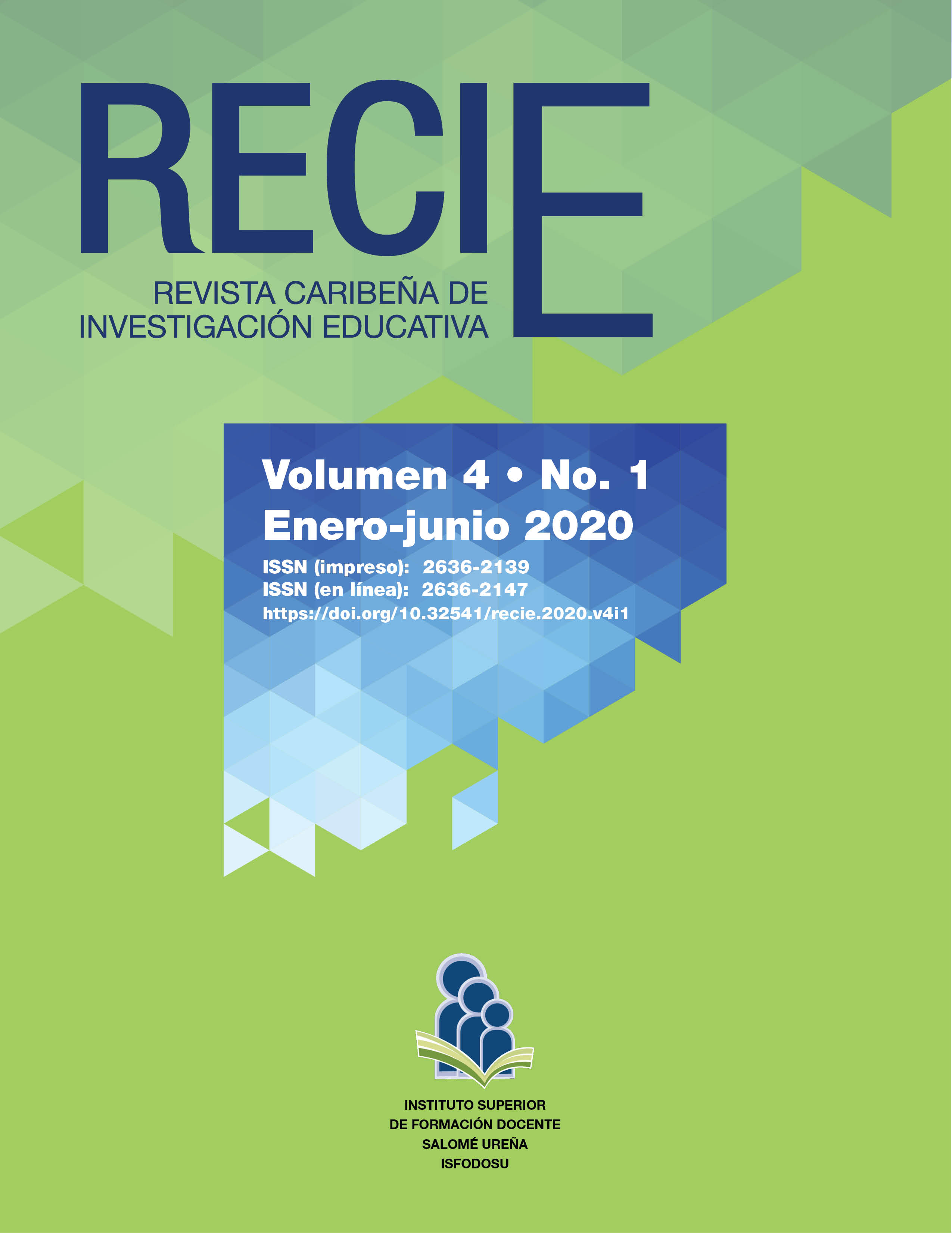Aceptación de la violencia de género en docentes de escuelas públicas
Autores/as
Aída Mencía-Ripley
Universidad Iberoamericana, República Dominicana
[email protected] https://orcid.org/0000-0001-7510-4072Detalles
Publicado
Resumen
Por esta razón, este estudio exploró cómo la aceptación de tres dimensiones de la VG impacta las creencias de docentes de primaria con relación a las habilidades de niñas y niños en distintas asignaturas escolares. Las asignaturas escolares fueron Lectura y Escritura, Matemáticas, Ciencias y Deportes. En República Dominicana la respuesta ante la VG suele ser asistencial y reactiva a un suceso. Existe poca evidencia local sobre cogniciones y barreras actitudinales hacia la prevención de la violencia que permitan identificar cambios y acciones preventivas en la escuela. A través de un estudio con un diseño prospectivo, transversal y correlacional se evaluó el impacto de la aceptación de mitos de la VG en el ámbito escolar. Encontramos que los docentes por lo general aceptan mitos sobre las distintas formas de violencia de género, generalmente culpabilizando a las mujeres por su victimización. De igual manera aceptan estereotipos sobre habilidades académicas en función del género femenino o masculino, especialmente para las matemáticas, para la cual el modelo utilizado explicó un 12% de la varianza. Este estudio señala que el entorno educativo no solo replica desigualdades sociales, sino que, además, estos sesgos impactan las valoraciones que reciben los estudiantes por parte de sus docentes.
Palabras clave
Cómo citar
Descargas
Métricas
Citas
Barquín Ruiz, J., & Melero Zabal, M. (1994). Feminización y profesión docente: Internalización sexista del trabajo. Revista de Investigación en la Escuela, 22, 25-34.
Barredo Ibáñez, D., Liberia Vayá, I., Macías Cruzatty, A., Palomeque Guillén, V., Delgado Burgos,
M. Á., Zurbano-Berenguer, B., Espinoza-Lucas, M., García García, M. E., & Cedeño Delgado, G. (2014). Actitudes y percepciones sobre la violencia de género del personal docente y administrativo y de servicios de Manta: estudio del Colegio 5 de Junio (2014). Revista San Gregorio, 1, 38-45. https://bit.ly/32urG4f
Beilock, S. L., Gunderson, E. A., Ramirez, G., & Levine, S. C. (2010). Female teachers’ math anxiety affects girls’ math achievement. Proceedings of the National Academy of Sciences, 107(5), 1860-1863. https://doi.org/10.1073/pnas.0910967107
Carli, L. L., Alawa, L., Lee, Y., Zhao, B., & Kim, E. (2016). Stereotypes about gender and science: Women? scientists. Psychology of Women Quarterly, 40(2), 244-260. https://doi.org/10.1177/0361684315622645
Eagly, A.H., & Miller, D. I. (2016). Scientific Eminence: Where are the women? Perspectives on Psychological Science, 11(6), 899-904. https://doi.org/10.1177/1745691616663918
Friedrich, A., Flunger, B., Nagengast, B., Jonkmann, K., & Trautwein, U. (2015). Pygmalion effects in the classroom: Teacher expectancy effects on students’ math achievement. Contemporary Educational Psychology, 41, 1-12. https://doi.org/10.1016/j.cedpsych.2014.10.006
Expósito, F., Herrera, A., Valor-Segura, I., Herrera, M. C., & Lozano, L. M. (2014). Spanish adaptation of the Illinois sexual harassment myth acceptance. The Spanish Journal of Psychology, 17. https://doi.org/10.1017/sjp.2014.42
Glick, P., & Fiske, S. T. (2001). An ambivalent alliance: Hostile and benevolent sexism as complementary justifications for gender inequality. American psychologist, 56(2), 109. https://doi.org/10.1037/0003-066X.56.2.109
Heise, L., Ellsberg, M., & Gottmoeller, M. (2002). A global overview of gender based violence. International Journal of Gynecology & Obstetrics, 78, S5-S14. https://doi.org/10.1016/S0020-7292(02)00038-3
Henry, F. (2015). Survey of Women in the Academies of the Americas. Interamerican Network of Academies of Sciences. https://bit.ly/32A1y8p
López Ojeda, E. (2006). Análisis sociolingüístico: pautas de observación y análisis del sexismo. Los materiales educativos. Interlingüística, (17), 630-639. https://bit.ly/2R9C2V3
McMahon, S., & Farmer, G. L. (2011). An updated measure for assessing subtle rape myths. Social Work Research, 35(2), 71-81. https://doi.org/10.1093/swr/35.2.71
Mencía-Ripley, A., Sánchez-Vincitore, G., Garrido, L., & Aguasvivas, J. (2015). USAID-Leer Baseline
Report. https://bit.ly/2NMXhsw
Mingo, A. (2010). Ojos que no ven...Violencia escolar y género. Perfiles Educativos, 32(130), 25-48.
National Sexual Violence Resource Center (NSVRC) (2015). Statistics about Sexual Violence.
http://bit.ly/2kVs2kE
Pérez Martínez, V. T., & Hernández Marín, Y. (2009). La violencia psicológica de género, una forma encubierta de agresión. Revista Cubana de Medicina General Integral, 25(2).
Peters, J. (2008). Measuring myths about domestic violence: Development and initial validation of the domestic violence myth acceptance scale. Journal of Aggression, Maltreatment & Trauma, 16(1), 1-21. https://doi.org/10.1080/10926770801917780
Piedra, J., García Pérez, R., Fernández García, E., & Rebollo, M.A. (2014). Brecha de género en educación física: Actitudes del profesorado hacia la igualdad. Revista Internacional de Medicina y Ciencias de la Actividad Física y el Deporte, 14 (53), 1-21. https://bit.ly/2WV9xLK
Plan Internacional República Dominicana (2017). Niñas Esposadas. Caracterización del matrimonio infantil forzado en las provincias de Azua, Barahona, Pedernales, Elías Piña y San Juan. Planteamientos (2), 1-32. https://bit.ly/33xcvIS
Roberts, R. E., Phinney, J. S., Masse, L. C., Chen, Y. R., Roberts, C. R., & Romero, A. (1999). The structure of ethnic identity of young adolescents from diverse ethnocultural groups. The Journal of Early Adolescence, 19(3), 301-322.
https://doi.org/10.1177%2F0272431699019003001 Sánchez-Díaz, L. Street harassment perception and it relations with self-objectification of women. INTERdisciplina, 7(17), 153-170. https://doi.org/10.22201/ceiich.24485705e.2019.17.67534
Sánchez-Vincitore, L.V., Garrido, L.E., Martínez, L., & Mencía-Ripley, A. (2017). End of Second Grade Reading Assessment of USAID’s Read Project: Academic Year 2016-2017. https://bit.ly/2CtjQgR
Smith, T. B., & Silva, L. (2011). Ethnic identity and personal well-being of people of color: A meta-analysis. Journal of Counseling Psychology, 58(1), 42. https://doi.org/10.1037/a0021528
Süssenbach, P., Eyssel, F., Rees, J., & Bohner, G. (2017). Looking for blame: Rape myth acceptance and attention to victim and perpetrator. Journal of interpersonal violence, 32(15), 2323-2344. https://doi.org/10.3389/fpsyg.2018.02690
Süssenbach, P., Eyssel, F., Rees, J., & Bohner, G. (2017). Looking for blame: Rape myth acceptance and attention to victim and perpetrator. Journal of interpersonal violence, 32(15), 2323-2344. https://doi.org/10.1177%2F0886260515591975
Van Mier, H. I., Schleepen, T. M. J., & Van den Berg, F. C. G. (2018). Gender Differences Regarding the Impact of Math Anxiety on Arithmetic Performance in Second and Fourth Graders. Frontiers in Psychology, 9, 2690. https://doi.org/10.3389/fpsyg.2018.02690
